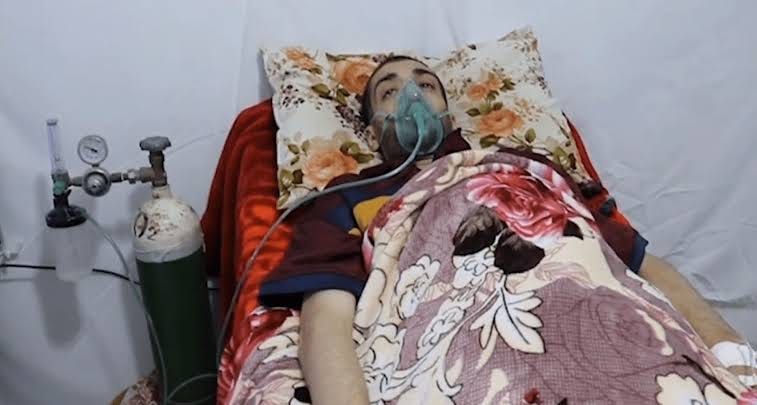10 years hostage in Gaza: Avera Mengistu & Hisham al-Sayed released
Tragedy at the intersection of race, class, mental health, & Hamas
Yesterday, after over a decade in captivity, Hamas released two hostages: Avera Mengistu (38) and Hisham al-Sayed (37).
The hostage releases have occurred in small batches over the last few weekends, and I’ve tuned in to watch the family reunification videos which are heartbreaking and rage-inducing. A few particularly stuck with me, like French-Israeli Ofer Kalderon seeing his partner or the 20-year-old violinist Agam Berger reuniting with her family.
Not to mention Yarden Bibas, whose wife, Shiri, and two sons, Kfir (10 months) and Ariel (4) came home in caskets after months of uncertainty as to their status.
In the wake of October 7, I learned about Avera Mengistu and Hisham al-Sayed. When Hamas took its 251 hostages, many of whom were not Israeli, the mass kidnapping resurfaced the forgotten (or overlooked) stories of the two men who vanished ten years earlier.
Their stories are simple and complicated. Avera and Hisham walked into Gaza and didn’t walk out, the former in 2014 and the latter in 2015. Both suffer from mental illness and are from minority groups in Israel, two factors that seemed to contribute to their long captivity. While many of the freed hostages appeared jubilant and emotional upon seeing their families, Avera and Hisham appeared dazed and vacant.
Avera Mengistu
Israel has a small Ethiopian Jewish community known as Beta Israel. The Mengistu family moved to Israel in 1991 as part of Operation Solomon (which is a wild story: 1,000 people can fit on a 747?!) and settled in the town of Ashkelon, a few miles from Gaza. One of ten kids, Avera’s mental health declined after the death of one of his brothers and deteriorated sharply in the time leading up to his disappearance in 2014.
His family advocated for his release, including making a 2015 trip to Switzerland to appeal to the Red Cross and Amnesty International, to no avail. I don’t know much about the ins and outs of Israeli society, but it’s clear race and class were factors in the slow-moving and murky efforts to free Avera.
Hisham al-Sayed
Unlike the other hostages who were paraded through an orchestrated crowd; bequeathed with goody bags and macabre certificates; and made to pose on stage for photos (ostensibly directing crowd-pleasers like kissing their captors’ heads, as in the case of Omer Shem Tov…who is kind of my hero for writing ‘I want a hamburger’ on a whiteboard while being airlifted to Israel); Hisham al-Sayed was released with no fanfare “out of respect for his family because of his Palestinian roots” per Hamas. 🤨
He is simply vacant.
I (obviously) don’t know this man at all, but you can tell he’s been through hell. When his mother hugs him, it’s as if she feels that the son who disappeared in 2015 didn’t return with the physical person in front of her.
Hisham appears to eke out a slight smile when his dad hugs him, asking him in Arabic, “Kayf halek, kuwayis?” (How are you? You’re OK?)
The al-Sayed family are Muslim Bedouins, another marginalized group in Israel. Hisham also suffers from schizophrenia, which may have factored into his decision to walk into Gaza. Like Avera, it remains to be seen how Hisham’s mental health will recuperate after spending years captive.
“He has no personality left. He is ruined. They abused him, especially mentally. Not with beatings or lashes, but mentally he is broken. He’s not a person anymore. When we saw him walking on his feet, it encouraged us. But during our first meeting with him, after the initial hug, I realized he wasn’t responding, and that was when I broke. It was the first time in years that I cried,” Hisham’s father Sha’ban al-Sayed.
A few years ago, I was sitting in my car waiting in the single-lane parking lot in one of those blink-and-you-miss-it strip malls—the kind that usually has some combination of gyros, cellphone repair, liquor, ‘easy’ insurance, and Dunkin Donuts. The strip mall wasn’t in a ‘bad’ area per se, but in typical Chicago fashion it was a forgotten spot surrounded by semi-affluence and dead people (a cemetery.)
From around the corner of a maze of anonymous three-flats, two people approached one of the stores: a determined-looking man in his 20s (probably needing to score) and what appeared to be a human zombie. My jaw must have dropped when I saw the girl: She was clearly drugged with something so powerful that she could barely walk, her arms slightly raised as if she was walking in the dark and her mouth dangling open, drool slowly cascading out of it. Like a vacant lemming, she followed the man around in and out of the stores, and within a few minutes, they were gone.
The image of this girl still haunts me. At the time I wondered how life had brought her to that point and today I sadly wonder if she’s still alive. People like her often languish under society’s radar: forgotten, neglected, and dismissed. She came to mind when I watched the videos of Avera and Hisham.
I hope the world hears Avera and Hisham’s stories; I hope the Israeli government provides them with the rehabilitation and treatment they so desperately deserve; and I hope the world sees Hamas for what they are.








These 2 vulnerable citizens unwittingly crossed into Gaza & were « captured » who’d use such a word & then imprisoned for decades by Hamas & Gazans who refused to let anyone know if they were dead or alive. Plus, the IDF found the two bodies of the IDF soldiers that had been held in Gaza since 2014. And the IDF rescued the 21 year old Yazidi sex slave who’d been purchased by a Gazan when she was 11 years old from ISIS.